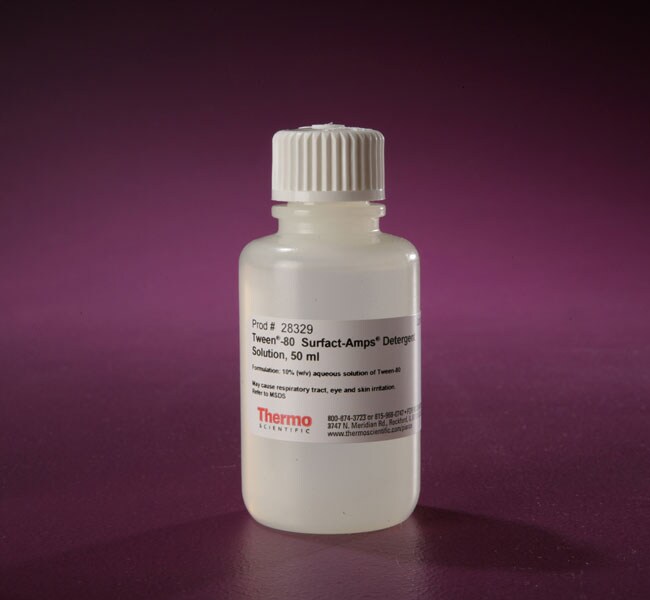Search Thermo Fisher Scientific

Thermo Scientific™
Tween™ 80 Surfact-Amps™ Detergent Solution
Thermo Scientific Tween-80 Surfact-Amps Detergent Solution is a highly-purified Tween™ 80 detergent stabilized as a 10% solution (w/v) and packagedRead more
| Catalog Number | Quantity |
|---|---|
| 28329 | 50 mL |
| 28328 | 6 x 10 mL |
| 28230 | 500 mL |
Catalog number 28329
Price (USD)
151.65
Online Exclusive
180.00Save 28.35 (16%)
Each
-
Quantity:
50 mL
Price (USD)
151.65
Online Exclusive
180.00Save 28.35 (16%)
Each
Thermo Scientific Tween-80 Surfact-Amps Detergent Solution is a highly-purified Tween™ 80 detergent stabilized as a 10% solution (w/v) and packaged under nitrogen in glass ampules or non-leaching HDPE bottles, ensuring it's stability and eliminating the accumulation of peroxides and degradation products.
Features of Tween-80 Surfact-Amps Detergent Solution:
• Tween 80—a popular nonionic detergent for use in ELISA, Western blotting and other immunoassay PBS or TBS wash buffers
• Accurate—precise 10% detergent solution in ultrapure water
• Easy-to-use—solution is simple to dispense and dilute for use
• Exceptionally pure—less than 1.0μeq/mL peroxides and carbonyls
• Stable—packaged under inert nitrogen gas in glass ampules or HDPE bottles
Properties of Tween 80:
• Molecular Weight: 1310g
• Detergent Class: Nonionic polyoxyethylene surfactant
• Aggregation Number: 60
• Micelle Molecular Weight: 76,000g
• Critical Micelle Concentration (CMC): 0.012 mM (0.0016%, w/v)
• Cloud Point: Unknown
• Dialyzable: No
Specifications for Tween 80 Surfact-Amps Detergent Solution:
• Visual: Slightly hazy to cloudy, colorless solution, free of particulates; may form layers.
• Concentration: 10.0±1.0%
• Oxidants: ≤1.0μeq/mL
• Carbonyls: ≤1.0μeq/mL
• Suspended Solids: Residue present must not exceed Residue Reference.
Related Products
Surfact-Amps™ Detergent Sampler
Features of Tween-80 Surfact-Amps Detergent Solution:
• Tween 80—a popular nonionic detergent for use in ELISA, Western blotting and other immunoassay PBS or TBS wash buffers
• Accurate—precise 10% detergent solution in ultrapure water
• Easy-to-use—solution is simple to dispense and dilute for use
• Exceptionally pure—less than 1.0μeq/mL peroxides and carbonyls
• Stable—packaged under inert nitrogen gas in glass ampules or HDPE bottles
Properties of Tween 80:
• Molecular Weight: 1310g
• Detergent Class: Nonionic polyoxyethylene surfactant
• Aggregation Number: 60
• Micelle Molecular Weight: 76,000g
• Critical Micelle Concentration (CMC): 0.012 mM (0.0016%, w/v)
• Cloud Point: Unknown
• Dialyzable: No
Specifications for Tween 80 Surfact-Amps Detergent Solution:
• Visual: Slightly hazy to cloudy, colorless solution, free of particulates; may form layers.
• Concentration: 10.0±1.0%
• Oxidants: ≤1.0μeq/mL
• Carbonyls: ≤1.0μeq/mL
• Suspended Solids: Residue present must not exceed Residue Reference.
Related Products
Surfact-Amps™ Detergent Sampler
For Research Use Only. Not for use in diagnostic procedures.
Specifications
Quantity50 mL
Reagent TypeDetergent Solution
FormLiquid
Product LineSurfact-Amps™, Tween™
Product TypeDetergent
Unit SizeEach
Contents & Storage
Store in a cool, dry, and well-ventilated area